That´s the nice thing about "OPTIONAL"....... meaning you don´t have to do it 😊Sorry one last dumb question. Should the optional line drivers be populated even if they are not going to be used in the near future?
Hello,Hello DT!
Just under 10Vrms means 28Vpp at f=1kHz, of course you are already slapping the rails.
Let's calculate back 14Vp/16 = 875mVp, 875mVp/23 = 38mVp. Well, the cascaded input stage should be able to supply and process 1.75Vpp without complaint. 3.8mAp should also be no problem for the 1st op-amp at Rload=230Ohm.
Should! First of all, the question of the highest possible input level must be clarified. What does the Ortofon 2M blue spit out? The data sheet says 5.5mVrms ... etc.pp. Sampling capability 80µm -> +/-40µm !?
Perhaps measure again directly at the exit of the first stage or at the entrance of the 2nd stage.
greetings,
HBt.
I think of it as kissing the rails. Add just one more increment of input Voltage from 29mVrms to 30mVrms and the top of the sine wave output begins to flatten (clip) and the THD+N jumps up to near 1%.
For the sake of discussion, the question of the highest possible input level, is a good question, any one know what the voltage output of the M2 Blue is with one of the big surface clicks or pops?
My thinking is to clean or replace the vinyl.
measure again directly at the exit of the first stage. Sure I will measure at entrance of the 2nd stage.
Thanks DT
I’m still working it. Over the weekend I took out the xlr wires, ran new rca wires and grounded the shields to signal ground on one end, and made sure all the chassis parts have continuity. Still hum with the turntable plugged in but not really present if not connected. I made sure there were no crossed grounds / loops on the turntable. I have another turntable I am going to try at some point soon.@javaught
did you make any progress with your hum problem?
But you can easily determine this yourself and record it - post it here please.For the sake of discussion, the question of the highest possible input level, is a good question, any one know what the voltage output of the M2 Blue is with one of the big surface clicks or pops?
30mV is about 16 dB above the nominal 5mV@ 5cm/sec level so I guess it can happen.Is there any chance a 5mV output cartridge can output 30mV?
E.g. the Ortofon MM is specified 5mV at 1 kHz at 5cm/sec. What I miss it how "heavy" that 1 kHz test groove is modulated?
Looking at an old E+WW magazine (March 1996) there is a tube RIAA design by Morgan Jones. He made some interesting measurements by hooking a sampling scope to his gear and concluded that for his design a headroom of 34 dB was needed in his design.
This was for first stage/prior to equalization and considering ultrasonic signals caused by tip resonances. That was one of his arguments for using a tubed RIAA:
The article states that within the audio band he measured
- The most dynamic recording he had in his collection (Mobile fidelity recording of Beethoven's 9th) the musical signal level peaked at +16dB above 5cm/sec level (before equalization).
- Worst case output due to dust and scratches rose even higher, to +22 dB (caused by tip resonances of his MC coil).
The 34 dB mentioned above was derived from adding 6 dB to cater for pickups with particularly high output and a further 6 dB margin.
This seems like an overkill to me. 5mV +34dB is approximately 250 mV.
Last edited:
Hi Manniraj,
I would like ask about your build.
Did you buy a plate for PSU inlet square hole?
I would like ask about your build.
Did you buy a plate for PSU inlet square hole?
@tamra I got these cabinets pair of them - https://www.aliexpress.us/item/2251...t_main.18.4f3b1802IBo2VO&gatewayAdapt=glo2usa and the seller was not ready to customize the chassis. So I have to do it myself. If you are asking about the square IEC inlet hole, then that hole is by default offered in the chassis. I just used some 80/40mm aluminium visiting cards -https://www.amazon.com/dp/B08H6X9DKD?psc=1&ref=ppx_yo2ov_dt_b_product_details of 0.8mm thickness and cut them into half to fit inside the 40mm internal height. Used that as the template to drill the 16mm aviation plug hole.
I run an Ortofon 2M Bronze MM. I honestly don't know if my Pearl 3 is clipping over pops and clicks but they don't sound different to me than with my previous quite decent phono stage.
I run an Ortofon 2M Bronze MM. I honestly don't know if my Pearl 3 is clipping over pops and clicks but they don't sound different to me than with my previous quite decent phono stage.
Hello,
The concept is a little odd isn't it?
Is the the noise distorting?
DualTriode, Good point 😳
I will happily be using my Pearl-3 totally stock, as designed by Wayne, without losing sleep or worrying that anything may blow-up. May try some op-amp rolling though.
I think the important take-away is not if the noise is distorted or not, but rather that under extreme conditions clicks and ultrasonic may drive the op amp output to the rail.
The selected amp should not stick, but rather come out of clipping as gracefully as possible without adding further artifacts (and have low current noise, low input capacitance and good current-drive abilities).
I will happily be using my Pearl-3 totally stock, as designed by Wayne, without losing sleep or worrying that anything may blow-up. May try some op-amp rolling though.
I think the important take-away is not if the noise is distorted or not, but rather that under extreme conditions clicks and ultrasonic may drive the op amp output to the rail.
The selected amp should not stick, but rather come out of clipping as gracefully as possible without adding further artifacts (and have low current noise, low input capacitance and good current-drive abilities).
I would strongly recommend everybody to digitize (needle drop) few records themselves using e.g. Audacity. It isn't difficult. Then to check with their own eyes how often clipped clicks occur (assuming properly set recording level) and based on that to decide how important is astronomical headroom.
Food for thought, even if phono preamp has huge e.g. 50Vrms output capability, where could we feed with this output without clipping?
Food for thought, even if phono preamp has huge e.g. 50Vrms output capability, where could we feed with this output without clipping?
Dear LJT and DT,
you can easily read the maximum signal level, let's say voltage in mV_peak - see page 593, ISBN 978-0-08-096640-3 - and this is smaller than 25mVp, exactly as you can theoretically expect. 16* 23* 25mVp corresponds to 8.5Vp, which leaves a reserve of almost 4dB for this worst case. When it comes to the short scratches or clicks that Morgan Jones recorded, one must not forget that they are very short jumps or impulses. Around maximum amplitudes of around 2.4Vp directly in front of our (Peral 3) passive first order low pass (with the time constant of 75µsec). Now DT can use his DSO to record in a single shot how this impulse or jump is processed, deformed, smoothed... so a measurement is required at the input pin of our second stage OP. To get straight to the point, the known problem is not one (and generations of hobbyists in particular credit Wayne's chosen order of combinations with solving a relevant problem that doesn't really exist). Was that clear enough?
Bye,
HBt.
you can easily read the maximum signal level, let's say voltage in mV_peak - see page 593, ISBN 978-0-08-096640-3 - and this is smaller than 25mVp, exactly as you can theoretically expect. 16* 23* 25mVp corresponds to 8.5Vp, which leaves a reserve of almost 4dB for this worst case. When it comes to the short scratches or clicks that Morgan Jones recorded, one must not forget that they are very short jumps or impulses. Around maximum amplitudes of around 2.4Vp directly in front of our (Peral 3) passive first order low pass (with the time constant of 75µsec). Now DT can use his DSO to record in a single shot how this impulse or jump is processed, deformed, smoothed... so a measurement is required at the input pin of our second stage OP. To get straight to the point, the known problem is not one (and generations of hobbyists in particular credit Wayne's chosen order of combinations with solving a relevant problem that doesn't really exist). Was that clear enough?
Bye,
HBt.
Actually, it's already a bit strange, but well, I connected a recorder / meter - and, on average, expressed as RMS: 3.5mV undistorted for "tangoseis, a hommage to Astor Piazolla" with the cheap AT VM95C. So this voltage will not upset the Pearl 3 at all!
Thanks hbtaudio! I have a Denon DL-110 and three of the AT-VM95 series. I use a Scarlett 2i2 to record the output of the Pearl 3, and find the level is quite similar for all four cartridges. I haven't heard audio clipping so your report is good news.
Sometimes I hear transients in percussion that I did not hear with other RIAA preamps but the Pearl 3 is very 'fast' sounding. The Pearl 3 seems to respond well to harsh pops. I looked at the wav file in Audacity and the pop can clip where I set my level but there is no ringing and the waveform immediately after the pop returns to normal without hysteresis. I can use Wave-Corrector on the file to remove the loud pops completely, leaving the audio minimally touched. 🙂
Sometimes I hear transients in percussion that I did not hear with other RIAA preamps but the Pearl 3 is very 'fast' sounding. The Pearl 3 seems to respond well to harsh pops. I looked at the wav file in Audacity and the pop can clip where I set my level but there is no ringing and the waveform immediately after the pop returns to normal without hysteresis. I can use Wave-Corrector on the file to remove the loud pops completely, leaving the audio minimally touched. 🙂
Since we want to look at the worst-case scenario, I'll add the peak values for the aforementioned long-playing record and the MM system, this time observed with the (analog) oscilloscope in real time - since my youth I've found this mode the most interesting, observing the time signal.
Vmax never exceeds 17mV(peak), so again no problem for virtually any equalizer, especially for the Pearl, which is what the dance is all about.
kind regards,
HBt.
Vmax never exceeds 17mV(peak), so again no problem for virtually any equalizer, especially for the Pearl, which is what the dance is all about.
kind regards,
HBt.
Today I went for a walk in the neighborhood and gave overload some thought.
You know that these cartridge's have a finite dynamic range. Amplified to little some of the small detail may get lost in the noise floor. Amplified too much some of the large grandiose things may be clipped or distorted in the upper limits of the power supply rails.
If you reserve 40dB's of headroom to capture the dynamic range of damaged vinyl you will be sure to be giving up small signal detail to the grass on the noise floor. The noise floor is there all day every day even for a shiny new LP.
Much of this conversation (beyond a point) is a solution in search of a problem.
Just for fun posted below are a photo of the neighborhood, time domain plots, and frequency domain plots someone else can post the dollar domain graphics.
Out For a Walk:

No clipping:
A little clipping:
More clipping:
Thanks DT
mVrms input levels
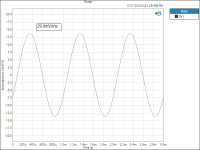
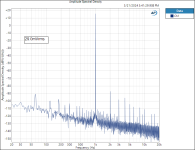
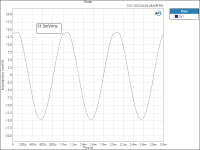

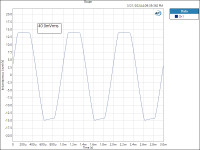
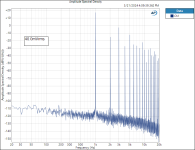
You know that these cartridge's have a finite dynamic range. Amplified to little some of the small detail may get lost in the noise floor. Amplified too much some of the large grandiose things may be clipped or distorted in the upper limits of the power supply rails.
If you reserve 40dB's of headroom to capture the dynamic range of damaged vinyl you will be sure to be giving up small signal detail to the grass on the noise floor. The noise floor is there all day every day even for a shiny new LP.
Much of this conversation (beyond a point) is a solution in search of a problem.
Just for fun posted below are a photo of the neighborhood, time domain plots, and frequency domain plots someone else can post the dollar domain graphics.
Out For a Walk:

No clipping:
A little clipping:
More clipping:
Thanks DT
mVrms input levels






Last edited:
I would strongly recommend everybody to digitize (needle drop) few records themselves using e.g. Audacity. It isn't difficult. Then to check with their own eyes how often clipped clicks occur (assuming properly set recording level) and based on that to decide how important is astronomical headroom.
Food for thought, even if phono preamp has huge e.g. 50Vrms output capability, where could we feed with this output without clipping?
I've been doing needle drops since the 90s when I got my first 24/96 AD/DAC. Heck, I got a lot of work with Cubase snipping out the clicks and pops, I learned that just trimming out the very short period of the leading edge of the noise wave front takes care of it.... doing it automatically doesn't work as well as it tends to remove too much of the music... mostly the treble. It robs the sparkle out of the music. So, I became a master at this.... spent lots of hours cleaning up recorded needle drops.
Overhead is not an issue unless you are really overdriving the preamp big time. When I started, driving a MC preamp with a 5 mV cartridge didn't give me any trouble. Perhaps it's because that preamp (tubed) has a lot of dynamic range so I could easily control the AD/DAC (Cubase as DAW) with the volume control without ever seeing any clipping in the signal due to the phono preamp overloading. It amazed me but the overhead on the AD and the preamp were such that they could easily handle the high output of the moving iron cartridge.
The problem is that my cartridge, turntable and preamp keep getting better, MUCH better, so why would I care about the sound of my system in 1998?
Better to keep the records clean and invest the money on cleaning machines, I think.
+++
BTW, my listening hours have been curtailed. I got a job, dang it. I was so happy retired... got my first Social Security check... now I'll have to return it. Job is remote so I'm getting used to it, so I'm planning on doing 2 hours of listening a day...so back to op amp rolling.
Any suggestions? The Bursons so far are the best but they are very picky with the circuit. My P3 has DIP sockets.
Last edited:
- Home
- Amplifiers
- Pass Labs
- Pearl 3 Burning Amp 2023